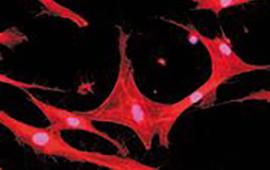Patterns of creation

In Summary
- This article featured in Swinburne’s 2017 ‘Research Impact’ magazine, produced in association with Nature Publishing Group.
Controlling the patterning on the surface of plastics may soon enable us to grow bone, fight infections and reproduce stem cells, thanks to research at Swinburne.
Variations in the nanoscale structures on the surface of a material can alter the development of cells in the vicinity according to the work of Swinburne’s Polymer NanoInterface Engineering Group.
It opens potential for making minute changes to the plastic surface of cell cultures and medical devices in order to control how cells behave both inside and outside the body.
“Depending on the type of pattern and the type of cell, you get different responses. This means you have a starting point for controlling the cell pathway,” says group leader, Professor Peter Kingshott.
Through their research, Professor Kingshott’s team developed a new method to create patterns at the nanoscale, as existing methods were expensive and time-consuming, limiting their industrial application.
In collaboration with the CSIRO’s manufacturing unit, Professor Kingshott’s group worked on a technique based on the patterns left by crystal particles as a solution evaporates. Their method can be carried out in any laboratory, takes a few hours, rather than months, and is scalable to a practical size.
The Swinburne group also recently collaborated with the Stem Cells Australia network to develop a new, relatively cheap and time-efficient method to regress mature cells to stem cell form.
A particular crystal pattern was laid down on the polystyrene surface of cell incubating wells, which were filled with mature cells and a mixture of proteins known to trigger the transformation. In a matter of days, the cells attached to the surface of the well and were converted back to stem-cell form.
Previous methods of inducing this pluripotency have taken weeks and have required the insertion of a layer of a protein called vitronectin to achieve conversion.
By speeding up the process and removing a step, the Swinburne–Stem Cells Australia technique could lead to time and cost savings in what is quickly becoming a valuable medical field.
Professor Kingshott says the same approach could determine the behaviour of mature cells.
“It doesn’t necessarily have to be stem cells. It can be regenerating skin or regenerating bone.”
Professor Kingshott’s group has also shown that different surface patterns can repel bacteria, pointing to useful applications in medical implants and devices.
If catheters and bandages can be manufactured to repel bacteria, the need for antibiotics could be reduced and the growing microbial resistance to antibacterials negated.
The team is now working to determine why the different surface patterns affect cell behaviour.

